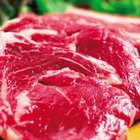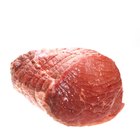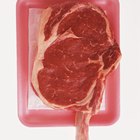
camij/iStock/Getty Images
All meat types share the same barometers of freshness, but there is more to determining quality than appearance and smell. One sign of freshness does not mean meat is fresh, nor does one sign of degradation mean meat has turned. You have to take all the quality indicators of meat into account as a whole to assess its freshness.
Butchering
The skill of meat's butchering, referred to as fabricating, indirectly indicates its freshness. A well-fabricated cut of meat shows the purveyor is skilled and economical, and he likely takes as much care keeping his meat fresh as he does cutting it. Just as purveyors lose money when their meat goes bad, they lose money on trim, or the portions of meat sliced from a large cut when breaking it down to a retail cut. Clean-cut edges and uniformity in the cuts' thickness and shape indicate the purveyor strives to keep food costs low, and purveyors who keep their food costs low keep their meat fresh; it goes with the territory.
Color
Fresh beef has a bright red color; the brighter the shade of red, the fresher the beef -- unless it's been treated with carbon monoxide to retain its color. If the meat has an unnatural red color, ask the supermarket if the beef has undergone carbon-monoxide treatment. On the other hand, a brownish-red color doesn't mean the meat isn't fresh; it just indicates it has been exposed to oxygen for as little as 30 minutes or has been frozen. Fresh poultry can range in color from bluish-white to yellow because of its diet, breed, age, activity level and subcutaneous fat. Fresh pork has a grayish-pink cast.
Smell
The fresh meat of any non-game animal has almost no smell. If meat is packaged, however, you may detect a slight musty smell. The innocuous musty smell arises when the moisture released from meat in its package, known as "purge," oxidizes. The musty smell differs greatly from that of degrading protein, which has an ammonia-like quality that is unmistakably rotten. Don't rinse meat before you cook it; purge is harmless. The cast-off from rinsing fresh meat, however, is not, and contaminates the surfaces it touches.
Feel
Fresh meat is firm, but some cuts spring back to their original shape slower than other cuts. Fatty beef cuts, for example, such as rib-eye, and beef cuts that have little connective tissue, such as tenderloin, spring back more slowly than tough rump cuts after you press them, but it doesn't indicate bad quality. However, if you press a cut of beef and the depressions remains, it means the protein has degraded, and it isn't fresh. When meat gets to this stage of degradation, it also has as an "off" smell and color. The firmness test applies to poultry and pork, too. Both should spring back to their original shape when pressed.
Insider Tips
Be wary of meat specials, especially in restaurants. Restaurants put meat dishes on special to make money from it before they have to toss it; it's often a last-ditch effort to salvage their weekly food costs. For example, if you see a 16-ounce USDA prime strip steak on special for $20 -- and the menu lists it at $30 -- it isn't the freshest meat in the house. However, a discounted dish doesn't indicate the meat has turned; it just means it's rapidly approaching its expiration date.
Related Articles

How to Know if Bacon Has Gone Bad

Is a Roast Bad If It Turns Brown?

What Causes Raw Steaks to Lose Red ...

How to Know if a Steak Is OK to Cook
The Differences Between Prime & Dry ...

How Do I Tell If Pork Has Turned Bad?

What Happens if You Cook Steak a Day ...

Should You Cook Raw Meat That's Gone ...

How to Know if Beef Cubes Are Bad

How to Know If Roast Beef Looks Good or ...

The Best Way to Cook a Silverside

How to Know if Marinated Steak Is Bad

How Long After Buying a Beef Roast Is ...

How Can I Tell If Lunch Meat Has Gone ...

How to Buy Oxtail

How Long Do You Keep Meat in Freezer?

What Does Spoiled Meat Smell Like When ...

How to Cook Muskrat

Can You Cook Meat Gone Bad?

What Are the Dangers of Eating Venison?
References
- U.S. Department of Agriculture: The Color of Meat and Poultry
- Clemson Cooperative Extension: Safe Handling of Pork
- U.S. Department of Agriculture: Water in Meat and Poultry
- U.S. Department of Agriculture: Washing Food: Does it Promote Food Safety?
- The New York Times: The Red-Meat Miracle, and Other Tales From the Butcher Case
Writer Bio
A.J. Andrews' work has appeared in Food and Wine, Fricote and "BBC Good Food." He lives in Europe where he bakes with wild yeast, milks goats for cheese and prepares for the Court of Master Sommeliers level II exam. Andrews received formal training at Le Cordon Bleu.
Photo Credits
camij/iStock/Getty Images